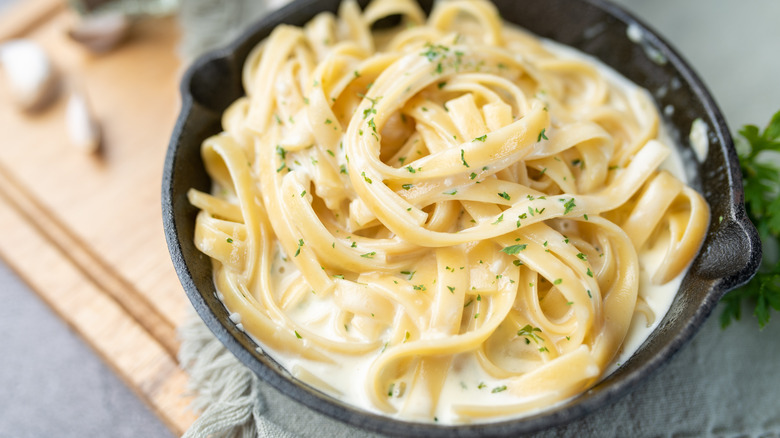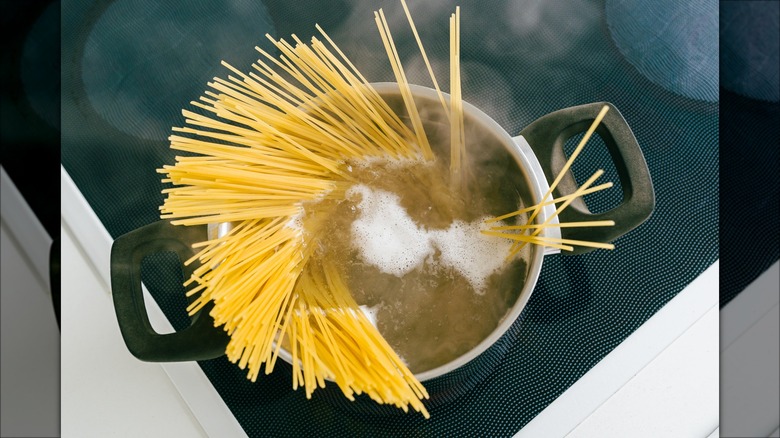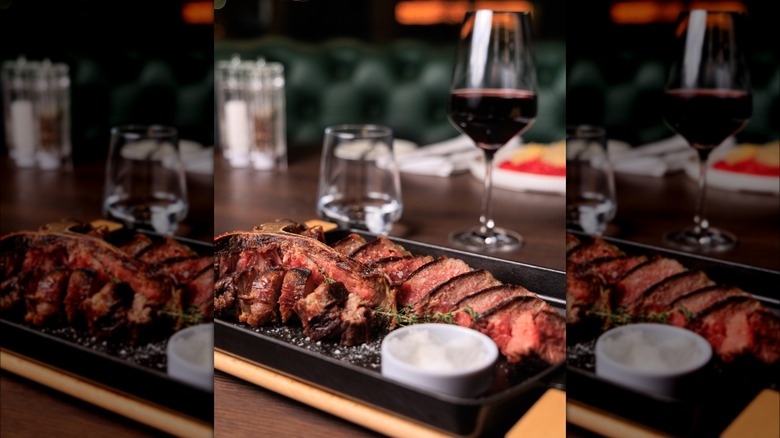3 Chefs Point Out The Biggest Mistakes You're Making When Ordering Traditional Italian Food
Dining in an Italian restaurant is and experience many look forward to. There are so many culinary delights to choose from. And, if you're lucky enough to be dining in an Italian restaurant in Italy — possibly even at one of the oldest restaurants in the world — then your taste buds may be in for an even bigger treat. However, ordering placing an order in an Italian restaurant is not as simple as you may think.
We reached out to three professional chefs, each of whom is an expert in cooking Italian food: Jon Butler is the Executive Chef at Kiki's La Quina in Quinta, California, Tommaso Iorio is a chef and the founder of Tuscany at Home in Los Angeles, Californian, and Antimo DiMeo is an executive chef and the co-owner of Bardea in Wilmington, Delaware. We learned that people make all sorts of mistakes when placing an order — including requesting items that aren't traditional Italian dishes, getting confused about which menu items pair well together, and not understanding what to expect when the entrée they ordered is served.
Requesting fettuccine Alfredo
If you live in America, one of your favorite Italian entrées may be fettuccine Alfredo. The dish features fettuccine pasta topped with a creamy sauce made from heavy cream, parmesan cheese, and garlic. However, even if this combination makes your mouth happy, it isn't something you should order at an Italian restaurant. "Requesting fettuccine Alfredo," is one of the top mistakes Chef Jon Butler highlights that Italian restaurant patrons can make.
"One telltale sign that a restaurant is not an authentic Italian restaurant will be having this dish on the menu," explains Butler. While here in America, we may associate fettuccine Alfredo with Italy, as Butler notes, it is not actually a popular entrée in Italy. If you see fettuccine Alfredo on a menu and are looking for a truly authentic Italian dining experience, you might want to consider choosing a different restaurant. Or, at least take Chef Butler's advice and "opt for a carbonara, cacio e pepe or amatriciana" for a more authentic option.
Ordering a pepperoni pizza in Italy
If you're traveling to Rome, Tuscany, Florence, or another Italian city, indulging in some pizza might be on your to-do list. Perhaps, you're craving a cheesy pizza covered with scrumptious, crispy pepperoni. Although there is nothing wrong with eating pepperoni pizza in Italy. However, according to Chef Tommaso Iorio, ordering one would be a mistake. He explains that if you request a pepperoni pizza, what you receive will not match what your expectations.
"Be aware that if you order pepperoni pizza you will receive pizza with peppers," Iorio cautions those planning a trip to Italy. Pepperoni translates to peppers in Italian (spelled peperoni) — quite different from our meaning of pepperoni. While you might not mind peppers on your pizza, if you're in the mood for pepperoni pizza, you won't be happy if you make this ordering mistake. Instead, Iorio says, "Ask for a 'Pizza al salamino piccante' for our version of pepperoni pizza."
Asking for Parmesan cheese on seafood dishes
You're probably starting to get the idea that what is served in Italian restaurants located in America isn't always truly authentic Italian food. Chef Jon Butler points out one other faux pas that many Americans make: requesting that Parmesan cheese be sprinkled over a seafood dish. Butler explains that Parmesan cheese doesn't really compliment seafood pastas. "Any seafood pastas with a cheese or cream-based sauce will be indicative of a non-authentic Italian restaurant," he shares.
Start by taking a few bites of the seafood entrée to see if you even need to do anything to modify it. In many cases, you'll discover that it tastes perfectly fine as is. If you do want to add a little something to it that will enhance the flavor without compromising the authenticity of the dish, Butler says, "you can request for fresh lemon to be squeezed on top."
Not being selective when ordering takeout or delivery
Dining in an Italian restaurant is an experience. However, there are times that you don't feel like leaving your home or would prefer to eat around your own dining room table. On nights such as these ordering your food for carryout or delivery can be convenient. However, according to Chef Tommaso Iorio, "Some Italian dishes should not be ordered to go or for delivery."
Ideally, he says it is best to eat most Italian dishes in the restaurant instead of taking them to go, but strongly recommends being selective if you decide to place a to-go order. "If you must order to go, order pizza or lasagna, vs. bruschetta or another pasta dish, because the longer pasta sits out, the mushier it becomes." Iorio explains that pasta continues to cook in the warm sauce, which can result in something less-than-appealing being delivered to your home.
Mixing pasta shapes and sauces
If you've read an Italian menu before, you've probably noticed that different sauces are often paired with different pasta shapes. It can be tempting to request that one of these entrées be paired with a different pasta shape than what is listed. However, according to Chef Jon Butler, making such a request and mixing pasta shapes and sauces isn't a good idea because "Italian pasta dishes typically have a pasta shape assigned for a specific sauce."
He explains, "Thin, long noodles will pair better with lighter sauces while ridged or tube-shaped pasta will pair better with thicker or creamier sauces." Even though it may be tempting to switch the pasta shapes for one that you typically like best, Butler says doing so can "compromise the taste and texture as well as how the pasta holds the sauce." Rely on the expertise of the chef who prepares the food so you can enjoy the best dining experience possible.
Requesting that fresh pasta be serve al dente
If you're used to cooking pasta at home or ordering from restaurants that only cook with dry pasta, you may prefer the pasta to be cooked al dente, which is still a bit firm in the middle, giving it a chewier consistency. In Italian, al dente means "to the tooth," which makes sense, as your teeth need to work a bit harder when chewing it. If you're dining at a restaurant that offers fresh pasta, Chef Tommaso Iorio explains that you should never request that it be cooked al dente.
This isn't solely an ordering faux pas, it is simply impossible. "Fresh pasta can never be served al dente. Due to its natural consistency, it will never be al dente," says Iorio. You'll either need to embrace the softer texture of cooked fresh pasta or order dry pasta if you want that little crunch in the finished dish.
Focusing on garlic
Heavily focusing on garlic when ordering your Italian meal is another mistake that both Jon Butler and Tommaso Iorio caution against. "It is a common misconception that Italian food contains a ton of garlic," Iorio explains. Garlic can be very overpowering, so you are unlikely to see it in many authentic dishes. Iorio adds, "As I always tell my clients, the ingredients in Italian dishes (or any dishes) should work like an orchestra. Not one ingredient should overpower others."
Similarly, Butler shares that asking for garlic bread when dining in an Italian restaurant is also a mistake. "Typically, Italian restaurants will not carry garlic bread," he says. Instead, Butler recommends opting "for a focaccia or grissini with olive oil as a starter." Once you get home, you can whip up some garlic bread in the air fryer, if you're craving the dish.
Not knowing which dishes are best served with dry pasta
If the Italian restaurant you're dining in offers fresh pasta, you may assume that you'll find the best flavor and texture by choosing the fresh pasta with a menu item you're considering. However, according to Chef Tommaso Iorio, doing so would not be a wise choice. "Certain famous sauces, such as carbonara, cacio e pepe and amatriciana, should be served with dry pasta in order to bring out the true essence of these sauces." Your dining experience isn't going to be the same if you opt for fresh pasta with these dishes. Tommaso explains, "the taste will not be authentic."
This is another example of when it is best to trust the chefs and waiters at the restaurant. Ask for their guidance when choosing the right pasta for a particular sauce you want to try, if they aren't already paired on the menu. If you're worried about missing out on the taste of fresh pasta, Iorio offers the reassurance that "dry pasta is just as delicious and healthy as fresh pasta. Especially pasta from Italy."
Never ordering Amatriciana
We all have our favorite Italian dishes that we like to order when we go to a restaurant. And, while there is nothing wrong with having a favorite, you may end up missing out if you're unwilling to try something new. According to Chef Antimo DiMeo, Amatriciana is the best thing to order in an Italian restaurant and something that everyone should try at least once.
DiMeo explains, "It's a true Italian classic that allows the quality of its ingredients to shine." The sauce, named after the town of Amatrice in the Rieti province in Italy, features three main ingredients; tomato sauce, pecorino cheese, and guanciale, or cured pork cheek. DiMeo says, "This is what Italian cuisine is all about, the sourcing of your ingredients means everything." DiMeo recommends pairing bucatini pasta with the sauce, but you may also see it listed on a restaurant menu with spaghetti or rigatoni.
Asking for pasta with chicken
In Italian restaurants in the United States, you may find a variety of chicken entrées paired with pasta, such as chicken Parmigiano, chicken fettuccine Alfredo, or creamy Tuscan chicken pasta. Order these if they sound appealing, but don't fool yourself by thinking you're eating a traditional Italian dish. Chef Tommaso Iorio explains that traditional Italian entrées do not mix pasta and chicken.
"One pasta recipe that you will likely not find in a restaurant in Italy is any pasta with chicken. So when ordering at a traditional Italian restaurant, "don't look for this item. You will not find it," explains Iorio. Requesting such a combination will surely result in some odd looks from the waiter or waitress, and you still get what you're asking for. So, if you're visiting Rome, Florence, or another Italian city, save yourself the trouble and decide whether you want pasta or chicken, instead, choose one or the other.
Customizing dishes too much
When you dine in an authentic Italian restaurant, there may be some items on the menu that you're interested in, but don't exactly match what you're in the mood for. For example, perhaps you want to substitute a white wine sauce for a tomato-based one. Or, maybe you really like the way a certain pasta dish sounds, but think it would be better with shrimp instead of scallops. However, according to Chef Jon Butler, you should refrain from making modifications to menu items. "Asking for too many adjustments to a traditional dish at an authentic Italian restaurant can be viewed as disrespectful as it will compromise its authenticity and flavor profile," he explains.
Whenever possible, Butler recommends trusting "the chef while only asking for adjustments if it involves dietary restrictions." Even then, make sure you ask for substitutions without sounding rude. If you don't think you'll enjoy a particular item as it is listed, you could always ask your server to describe it to you and help you learn more about the taste and texture. Another option would be to find something else on the menu that you'd be happy ordering as described.
Expecting Italian and American restaurant steaks to be the same
You can absolutely order a steak from an Italian restaurant. Even though steak often tastes different at a restaurant, you shouldn't expect an Italian steak to look and taste exactly like what you'd receive from an American steakhouse. Tommaso Iorio explains, "Italian steak is made differently. We don't have dry aged meat. The dry aged is something Italy started importing from America very recently." If you're familiar with the difference between Brazilian steakhouses and those in the U.S., it might not surprise you that Italian steaks are also unique.
Another key difference between Italian and American steaks relates to the marbling of the meat. Compared to American steaks which feature a lot of fat and marbling, Iorio explains, "In Italy, it is the exact opposite. Lean steaks are the favorite." Don't let these differences deter you from trying an Italian steak. Keep an open mind and you just might find that Italian steaks can also taste incredible.
Confusing Parmesan and Parmigiano cheese
There are many words and phrases to know when dining at Italian restaurants. For example, when you read an Italian menu, chances are you'll see the names of several types of cheese. Chef Tommaso Iorio cautions against assuming that Parmesan and Parmigiano are the same. "We use Parmigiano Reggiano or Grana Padano. Two very authentic cheeses made in Italy with lots of regulations and years of traditions." Parmesan cheese, he explains, is just not used in Italian dishes. If you see it listed as an ingredient on a menu, it can clue you in that you're not going to enjoy a truly authentic dining experience.
When dining at an Italian restaurant, Iorio recommends reading the menu and the ingredients closely — beyond simply looking for Parmigiano cheese. He says, "When you see a list of ingredients on a menu with the certifications such as DOP, IGP or STG, you can be sure the restaurant is using authentic Italian products. These labels are guaranteed by Italian and EU regulations, repressing authenticity and quality."













